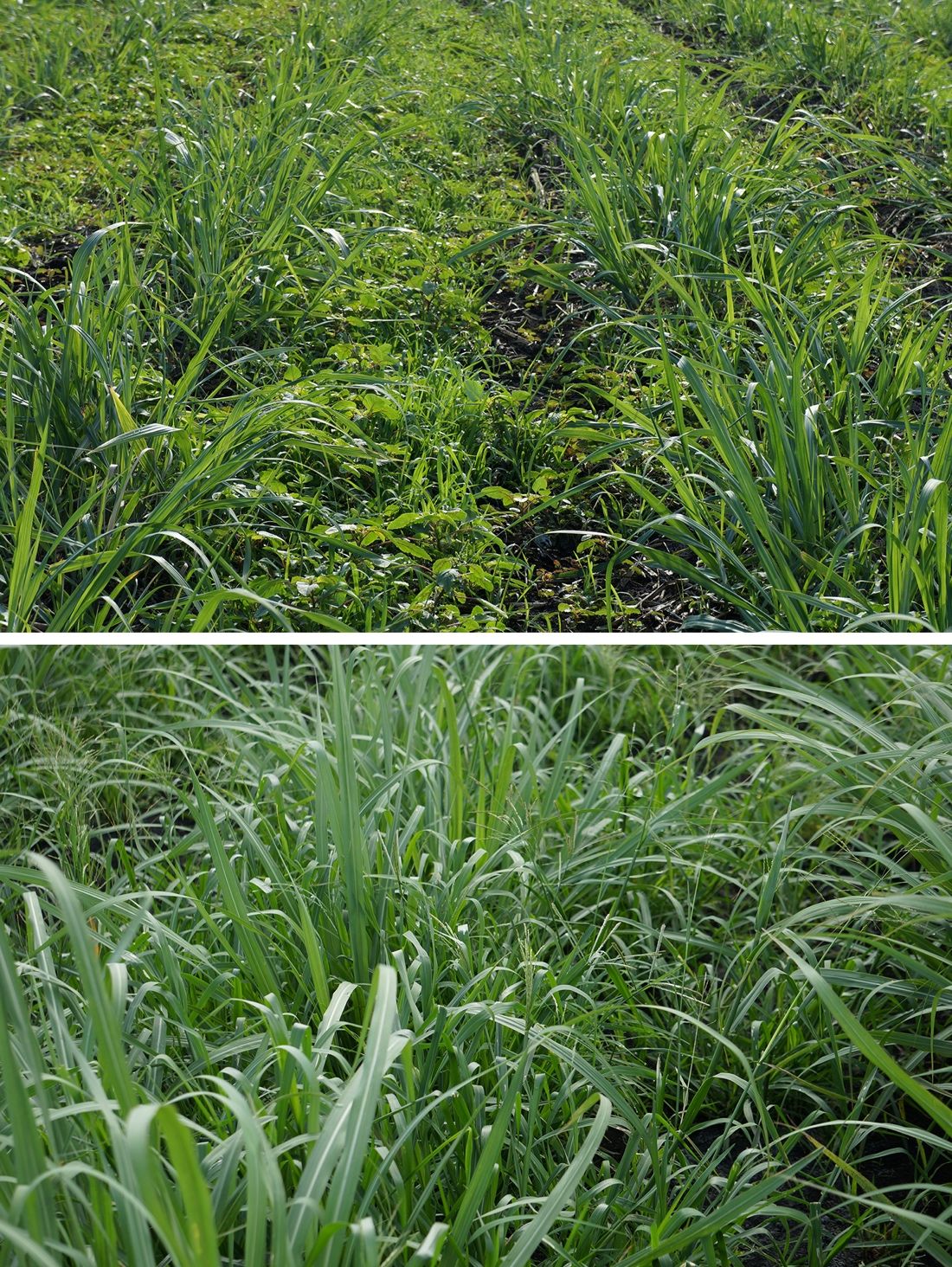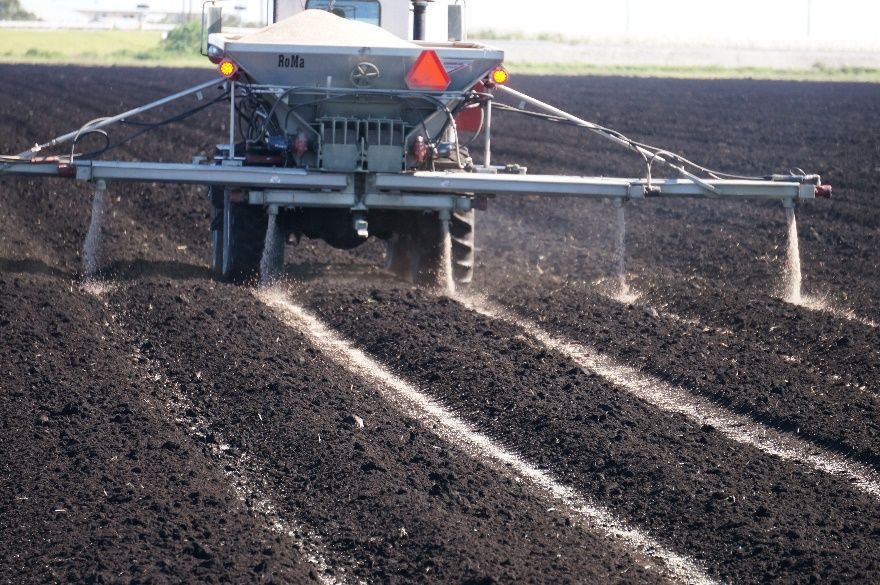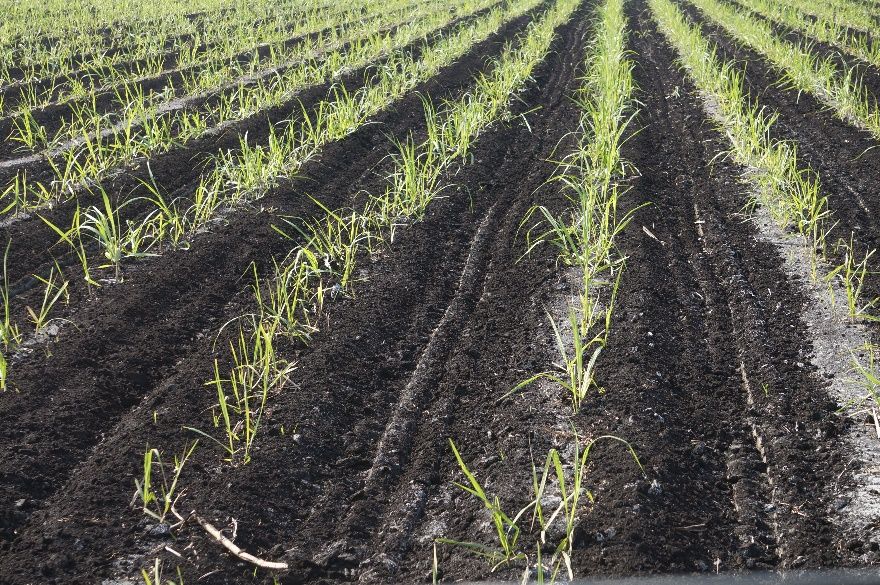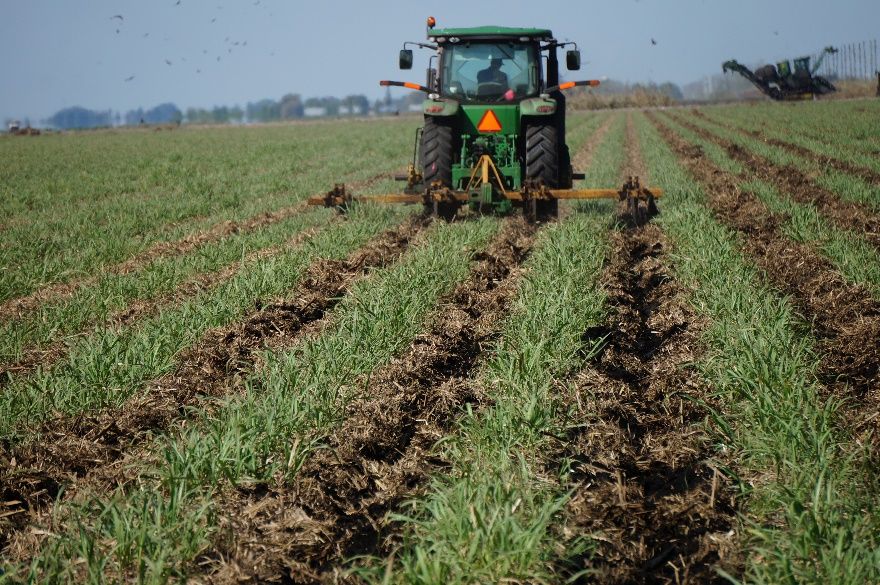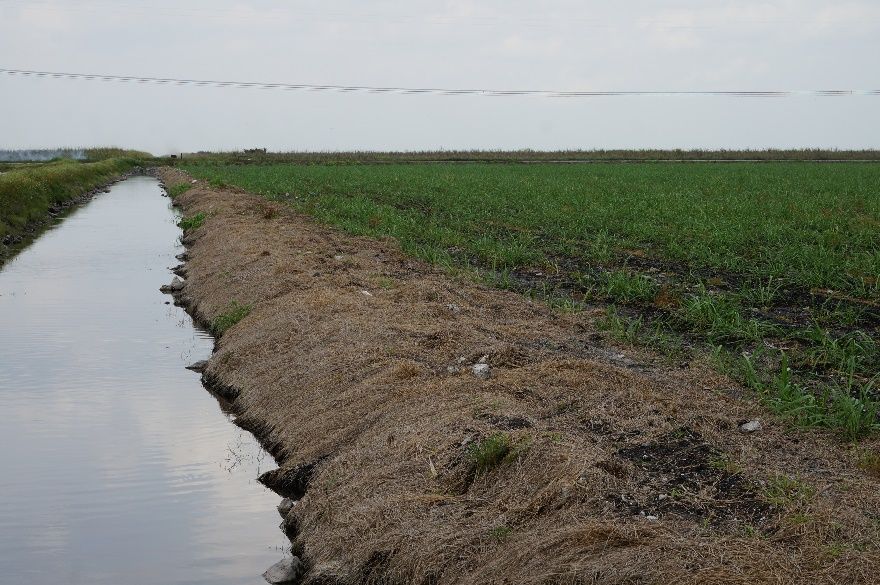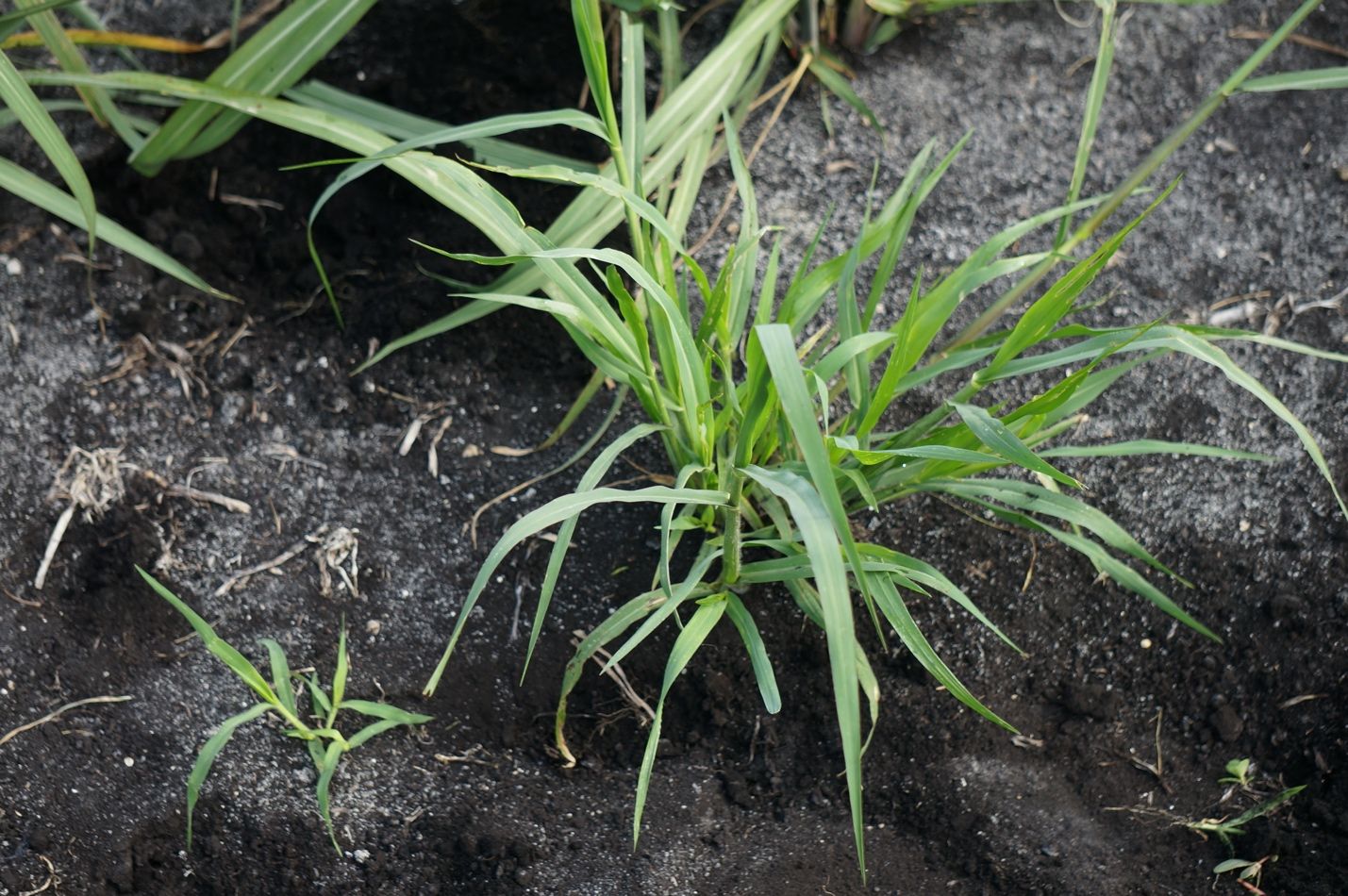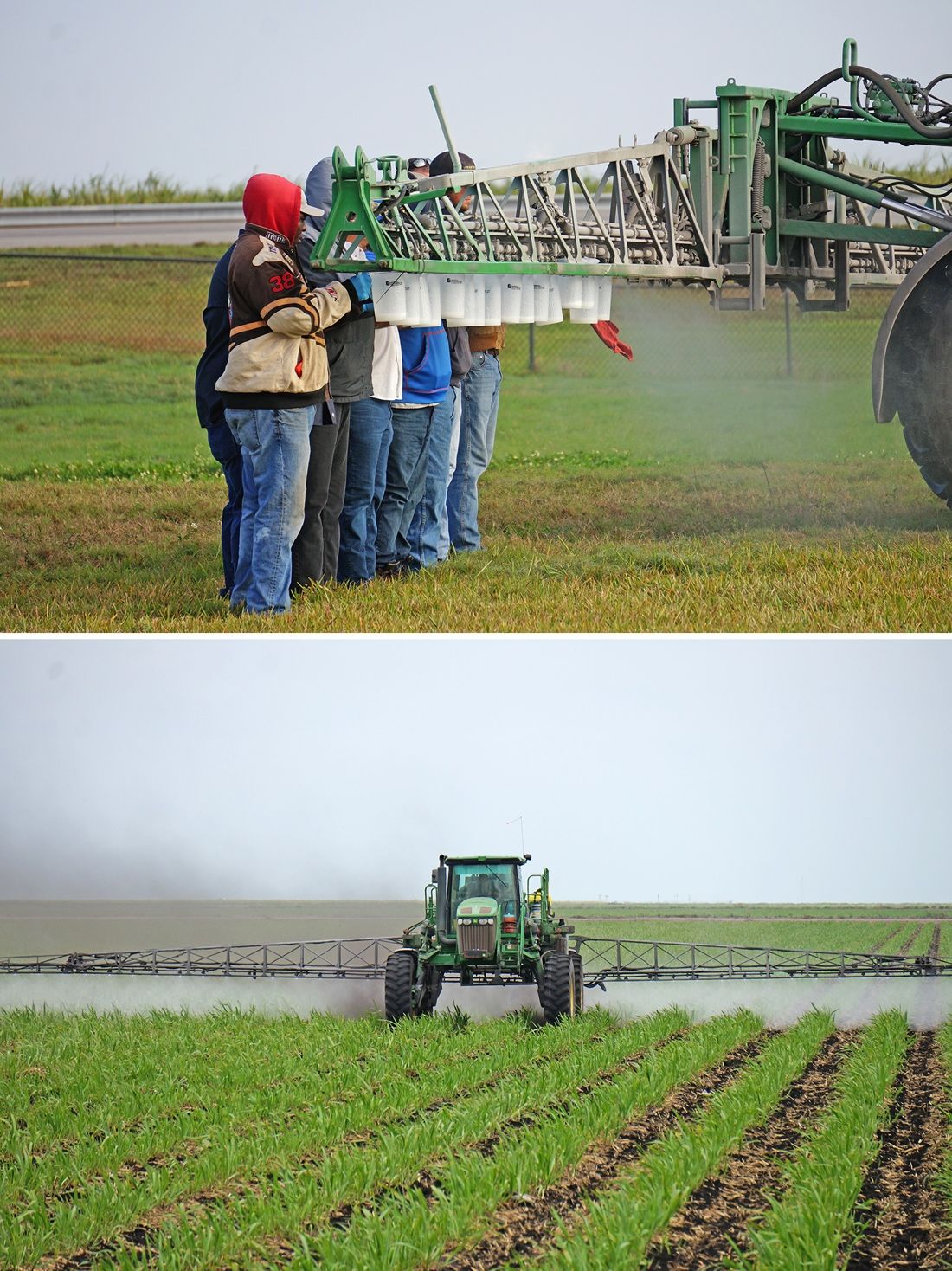|
FALL LAND MANAGEMENT
|
|
MUCK AND SANDY SOILS
|
|
Glyphosate (Several 4L or 5.5L)
|
9
|
32 fl oz/acre for 4L or 26 fl oz/acre for 5.5L for POST fallow; 4–5 qt/acre for 4L or 2.5–3.3 qt/acre for 5.5L for last stubble removal; max. 8.15 qt/acre for 4L and 5.9 qt/acre for 5.5 L
|
4 hours
|
For control of emerged, actively growing annual and perennial weeds (such as bermudagrass and torpedograss) in and around sugarcane or in fields to be planted to sugarcane. Apply during fallow period preceding planting. It can be used to remove last stubble of sugarcane crop. Control of sugarcane stubble will depend on sugarcane height and herbicide rate. New stubble growth should have at least 7 new leaves at the time of application. Allow 7 or more days after application before tillage. Consult the label for additional surfactants, specific rates of application for various weeds, and low rate technology application.
|
|
PREEMERGENCE—PLANT CANE
|
|
MUCK SOILS
|
|
Atrazine (Atrazine 4L or Atrazine 90DF)
|
5
|
4–8 pt/acre for 4L or 2.2–4.4 lb/acre for 90DF, max. 20 pt/acre for 4L or 11.1 lb/acre for 90DF
|
12 hours
|
For control of annual broadleaf and some grass weeds. Broadleaf weed control will be superior to annual grass control. Broadcast by ground equipment before sugarcane or weeds emerge at time of planting or ratooning. No mixing or loading within 50 ft of canals or any water body because of ground and surface water concerns. May be used with metribuzin (Tricor 75DF or Tricor 4F) to broaden weed control spectrum. Addition of pendimethalin (Prowl 3.3 EC or Prowl H2O 3.8 MS) can improve control of fall panicum and other annual grasses. Restricted Use.
|
|
Hexazinone + Diuron (DuPont K-4 60DG)
|
5
|
3.75–4.0 lb/acre, max. 4.0 lb/acre for PRE application or 7.5 lb/acre including any subsequent POST application
|
24 hours
|
For control of annual grass and broadleaf weeds. Application should be made immediately following planting and row packing, but prior to crop and weed emergence. For best weed control, application should be made to a firm, well-prepared seedbed free from excess clods or plant residue. When applying K-4 alone or in combination with other diuron-containing products, do not exceed 6 lb of diuron per acre. Do not apply within 234 days of harvest.
|
|
Pendimethalin (Prowl 3.3 EC or Prowl H2O 3.8 MS)
|
3
|
4.8–9.7 pt/acre for 3.3 EC or 4.2–8.4 pt/acre for 3.8 MS, max. 14.4 pt/acre for 3.3 EC or 12.5 pt/acre for 3.8 MS
|
24 hours
|
For control of most annual grasses and certain broadleaf weeds. Apply at time of planting or ratooning, but prior to weed emergence. Mechanical incorporation or rainfall within 7 days of application is needed to incorporate pendimethalin applied alone or in combination with metribuzin (Tricor 75DF or Tricor 4F) or atrazine (Atrazine 4L or Atrazine 90DF) into the soil, or activity will be significantly decreased.
|
|
Metribuzin (Tricor 75DF or Tricor 4F)
|
5
|
1.33–2.67 lb for 75DF or 2–4 pt/acre for 4F, max. 2.67 lb/acre for 75DF or 4 pt/acre for 4F
|
12 hours
|
For control of most broadleaf and certain grass weeds. Broadleaf weed control will be superior to annual grass control. May be used with atrazine (Atrazine 4L or Atrazine 90DF) to broaden weed control spectrum. Addition of pendimethalin (Prowl 3.3 EC or Prowl H2O 3.8 MS) can improve control of fall panicum and other annual grasses. Apply at time of planting or ratooning, but prior to weed emergence. Do not apply on sand soils.
|
|
Mesotrione (Callisto 4SC)
|
27
|
6.0–7.7 fl oz/acre, max. 7.7 fl oz/acre
|
12 hours
|
For control of annual broadleaf weeds. Apply after planting cane or after harvest of ratoon sugarcane. If weeds have already emerged at the time of application, add a crop oil concentrate (COC) at 1.0% v/v or a nonionic surfactant (NIS) at 0.25% v/v to the spray solution. Urea ammonium nitrate (UAN) at 2.5% v/v or ammonium sulfate (AMS) at 8.5 lb/100 gallons of spray solution can also be added. Addition of atrazine (Atrazine 4L or Atrazine 90DF) or ametryn (Evik 78.9DF) can improve broadleaf weed control. Two applications should not be made less than 14 days apart if a subsequent POST application is made.
|
|
Diuron (Direx 4L or Karmex 80DF)
|
5
|
1.6–3.2 qt/acre for 4L or 2–4 lb/acre for 80DF, max. 3.2 qt/acre for 4L or 4 lb/acre for 80DF
|
12 hours
|
For control of broadleaf weeds and annual grasses. Controls broadleaf better than grass weeds. Apply as a broadcast or band prior to weed emergence after planting or after harvesting the ratoon cane.
|
|
S-metolachlor + atrazine + mesotrione (Lumax 3.674 EZ)
|
15 + 5 + 27
|
2.75–3.75 qt/acre, max. 3.75 qt/acre
|
24 hours
|
Apply prior to planting, PRE after new plantings, or after harvest, but prior to re-emergence of ratoon sugarcane for control of broadleaf weeds, grasses, and nutsedges (yellow and purple nutsedges). If weeds have emerged at the time of application, add COC at 1% v/v or NIS at 0.25% v/v to the spray solution. In addition to COC or NIS, a spray grade UAN (e.g., 28-0-0) at 2.5% v/v or AMS at 8.5 lb/100 gallons of spray solution can be added to the spray solution. Restricted Use.
|
|
Clomazone (Command 3ME)
|
34
|
2.66–3.3 pt/acre, max. 3.33 pt/acre
|
12 hours
|
For control of annual grasses and broadleaf weeds. Bleaching of sugarcane leaves can occur if the crop is spiking at application. Higher rates should be used on muck soils. Can be combined with metribuzin (Tricor 75DF or Tricor 4F) or diuron (Direx 4L or Karmex 80DF) for bermudagrass suppression.
|
|
PREEMERGENCE—PLANT CANE
|
|
SANDY SOIL
|
|
Atrazine (Atrazine 4L or Atrazine 90DF)1
|
5
|
4–8 pt/acre for 4L or 2.2–4.4 lb/acre for 90DF, max. 17.2 pt/acre for 4L or 9.6 lb/acre for 90DF
|
12 hours
|
For control of annual broadleaf and some grass weeds. Broadleaf weed control will be superior to annual grass weed control. Good soil moisture or light rainfall is essential for improved efficacy. May be used in split application: 4 pt or 2.2 lb of formulated atrazine product per acre PRE followed by 4 pt or 2.2 lb of formulated atrazine product per acre as required. Application may be delayed until emergence of small weeds and sugarcane. Addition of pendimethalin (Prowl 3.3 EC or Prowl H2O 3.8 MS) can improve control of fall panicum and other annual grasses. No mixing/loading within 50 ft of canals or water bodies because of ground and surface water concerns. Restricted Use.
|
|
Diuron (Direx 4L or Karmex 80DF)
|
5
|
1.6–3.2 qt/acre for 4L or 2–4 lb/acre for 80DF, max. 3.2 qt/acre for 4L or 4 lb/acre for 80DF
|
12 hours
|
For control of broadleaf and grass weeds. Controls broadleaf better than grass weeds. Broadcast or band prior to weed emergence after planting or after harvesting ratoon sugarcane.
|
|
Mesotrione (Callisto 4SC)
|
27
|
6.0–7.7 fl oz/acre, max. 7.7 fl oz/acre
|
12 hours
|
For control of annual broadleaf weeds. Apply after planting cane or after harvest of ratoon sugarcane. If weeds have already emerged at the time of application, add COC at 1.0% v/v or NIS at 0.25% v/v to the spray solution. UAN at 2.5% v/v or AMS at 8.5 lb/100 gallons of spray solution can also be added. Addition of atrazine (Atrazine 4L or Atrazine 90DF) or ametryn (Evik 78.9DF) can improve broadleaf weed control. Two applications should not be made less than 14 days apart if a subsequent POST application is made.
|
|
S-metolachlor + atrazine + mesotrione (Lumax 3.674 EZ)
|
15 + 5 + 27
|
2.75–3.75 qt/acre, max. 3.75 qt/acre for PRE only application
|
24 hours
|
Apply prior to planting, PRE after new plantings, or after harvest, but prior to re-emergence of ratoon sugarcane for control of broadleaf weeds, grasses, and nutsedges (yellow and purple nutsedges). If weeds have emerged at the time of application, add COC at 1% v/v or NIS at 0.25% v/v to the spray solution. In addition to COC or NIS, a spray grade UAN (e.g., 28-0-0) at 2.5% v/v or AMS at 8.5 lb/100 gallons of spray solution can be added to the spray solution. Restricted Use.
|
|
Pendimethalin (Prowl 3.3 EC or Prowl H2O 3.8 MS)
|
3
|
4.8–7.2 pt/acre for 3.3 EC or 4.2–6.2 pt/acre for 3.8 MS, max. 7.2 pt/acre for 3.3 EC or 6.2 pt/acre for 3.8 MS
|
24 hours
|
For control of most annual grasses and certain broadleaf weeds. Apply at time of planting or ratooning, but before weeds emerge. Can be combined with atrazine (Atrazine 4L or Atrazine 90DF) to broaden weed control spectrum. Must be incorporated thoroughly and uniformly either by mechanical incorporation or rainfall within 7 days after application.
|
|
Flumioxazin (Valor SX 51WG)
|
14
|
6–8 oz/acre, max. 8 oz/acre or 12 oz/acre if used to assist in POST burndown
|
12 hours
|
For control of grass and broadleaf weeds. May be applied 2 weeks prior to planting and before sugarcane emerges. May be used to assist in POST burndown of weeds before sugarcane emergence. Control will be improved with the addition of 1.25% v/v COC or methylated seed oil (MSO), or 0.25% v/v of NIS. Sequential application can be made within 14 days after the first application if used to assist POST burndown. Residual activity is reduced when applied to soils with more than 10% organic matter.
|
|
Clomazone (Command 3ME)
|
34
|
2.66–3.3 pt/acre, max. 3.33 pt/acre
|
12 hours
|
For control of annual grasses and broadleaf weeds. Bleaching of sugarcane leaves can occur if the crop is spiking at application. Lower rates should be used on light or sand soils. Can be combined with diuron (Direx 4L or Karmex 80DF) for bermudagrass suppression.
|
|
POSTEMERGENCE
|
|
MUCK SOILS
|
|
Metribuzin (Tricor 75DF or Tricor 4F)
|
5
|
1.33–2.67 lb for 75DF or 2–4 pt/acre, max. 2.67 lb/acre for 75DF or 4 pt/acre for 4F
|
12 hours
|
For control of broadleaf weeds and certain grasses. Can be used as POST over-the-top or directed spray before row closing when weeds are less than 4 inches tall. Spray contact with sugarcane foliage may result in minor leaf chlorosis and/or necrosis. Do not use on sugarcane grown in sandy soils.
|
|
MUCK AND SANDY SOILS
|
|
S-metolachlor + atrazine + mesotrione (Lumax 3.674 EZ)
|
15 + 5 + 27
|
1.5–3.0 qt/acre, max. 3 qt/acre
|
24 hours
|
For broadleaf, grass, and sedge control. Apply before sugarcane reaches 20 inches in height. Applications can be made over-the-top or post-directed to actively growing weeds. If PRE application was made earlier in the season (not to exceed 3.75 qt/acre), only 1.5 qt/acre may be applied postemergence. The total amount of applied (PRE + POST) cannot exceed 5.25 qt/acre/year. If weeds have emerged at the time of application, add COC at 1% v/v or NIS at 0.25% v/v to the spray solution. In addition to COC or NIS, a spray grade UAN (e.g., 28-0-0) at 2.5% v/v (2.5 gallons/100 gallons spray solution) or AMS at 8.5 lb/100 gallons of spray solution can be added to the spray solution. Restricted Use.
|
|
2,4-D amine (Several 3.8L)2
|
4
|
1–2 qt/acre, max. 2 qt/acre
|
48 hours
|
For control of many broadleaf weeds including spiny amaranth, common ragweed, and morningglory species. Use high rates for large or difficult-to-control weeds such as alligatorweed, or when vines are climbing sugarcane plants. When tank-mixing products that contain 2,4-D, do not exceed a combined total of 2 qt/acre per crop cycle. Take care to prevent spray drift to sensitive crops, and consult the Florida Organo-Auxin herbicide rule prior to application.
|
|
Dicamba + 2,4-D amine (Several 3.87L)2
|
4
|
1–3 qt/acre, max. 5.5 qt/acre
|
48 hours
|
For control of many annual, biennial, and perennial broadleaf weeds. Apply anytime after weed emergence but prior to canopy closure. When possible, direct spray beneath the sugarcane canopy to minimize injury and maximize spray coverage of weed foliage. Use 1 qt/acre for control of annual weeds. Up to 3 qt/acre may be used for difficult-to-control perennial weeds in a single application (sugarcane injury may occur at 2–3 qt per application). Can be combined with asulam, atrazine (Atrazine 4L or Atrazine 90DF), ametryn (Evik 78.9DF), or metribuzin (Tricor 75DF or Tricor 4F) to broaden weed control spectrum. Take care to prevent spray drift to sensitive crops, and consult the Florida Organo-Auxin herbicide rule prior to application.
|
|
Atrazine (Atrazine 4L or Atrazine 90DF)
|
5
|
4–8 pt/acre for 4L or 2.2–4.4 lb/acre for 90DF, max. 17.2 pt/acre for 4L or 9.6 lb/acre for 90DF
|
12 hours
|
For control of annual broadleaf weeds. Treat before weeds exceed 1.5 inches in height. With good soil moisture or light rainfall, this treatment will provide some residual control of annual broadleaf weeds, especially on sandy soils. Injury may occur to sugarcane under moisture stress. Can be applied up to 3 times, as needed, at 4 pt/acre or 2.2 lb/acre. No mixing/loading within 50 ft of canals. Restricted Use.
|
|
Dicamba (Several 4L)2
|
4
|
0.5–2 pt/acre, max. 4 pt/acre
|
24 hours
|
For control of many annual, biennial, and perennial broadleaf weeds from weed emergence to sugarcane canopy closure. Use high rates for large or difficult-to-control weeds such as vines climbing sugarcane. Injury to sugarcane is likely to occur at high rates. When possible, direct spray to minimize sugarcane injury. Re-treat as needed with a maximum of 2 treatments per year. Can be combined with ametryn (Evik 78.9DF), asulam (Asulox 3.34 SC), atrazine (Atrazine 4L or Atrazine 90DF), or 2,4-D amine (Several 3.8L). Take care to prevent spray drift to sensitive crops, and consult the Florida Organo-Auxin herbicide rule prior to application.
|
|
Topramezone (Armezon 2.8EC)
|
27
|
0.5–2.0 fl oz/acre, max. 4 fl oz/acre
|
12 hours
|
For control of broadleaf weeds and grasses. Can be applied during the fallow period before sugarcane planting to 100 days before harvest. Efficacy is greater on grasses less than 12 inches tall. For fall panicum or other annual grasses greater than 12 inches tall, apply at 2 fl oz/acre; however, combination with asulam (Asulox 3.34 SC) provides better control of this size of grasses. Combinations with atrazine (Atrazine 4L or Atrazine 90DF) or metribuzin (Tricor 75DF or Tricor 4F) improve weed control. For bermudagrass, apply at 1 to 2 fl oz/acre early in the season at the onset of bermudagrass greenup or emergence of new leaves. Multiple sequential applications at 2- to 3-week intervals may be necessary for best control. For example, 2 fl oz followed by 2 fl oz, or 2 fl oz followed by 1 fl oz will provide acceptable control or suppression of bermudagrass at the aforementioned stages. Apply using MSO or COC at 1–1.5% v/v plus nitrogen fertilizer (AMS at 8.5–17 lb/100 gallons of water or UAN at 1.25–2.5 gallons/100 gallons of water).
|
|
Asulam (Asulox 3.34 SC)
|
18
|
6–8 pt/acre, max. 16 pt/acre
|
12 hours
|
For control of fall panicum and other annual grasses, but with a slow response. Apply to actively growing grass weeds and when sugarcane is at least 18 inches in height. Use the higher rate for grasses more than 12 inches tall for rescue control. Control improved with addition of NIS at 0.25–0.5% v/v or COC at 1% v/v. Addition of buffer may be beneficial for water pH above 9. Application may be broadcasted, banded, directed, semi-directed, or applied as a spot treatment. Apply when air temperature is at least 60°F for efficacy. Can be combined with trifloxysulfuron-sodium (Envoke 75DF) or topramezone (Armezon 2.8EC) for improved control of annual grasses greater than 12 inches tall.
|
|
Trifloxysulfuron-sodium (Envoke 75DF)
|
2
|
0.3–0.6 oz/acre, max. 1.5 oz/acre
|
12 hours
|
Provides good control of broadleaf weeds (alligatorweed, spiny amaranth, morningglory species), yellow and purple nutsedge, and grass weeds. Apply to weed seedlings less than 4 to 6 inches in height.
Can be applied pre-spiking to spiking at 0.3 oz/acre.
Apply over-the-top or as a directed spray.
For ratoon cane, over-the-top applications can be made until sugarcane reaches 24 inches in height. The 0.6 oz/acre rate may be applied as directed spray to sugarcane that is more than 18 inches tall through layby. May be tank mixed with ametryn (Evik 78.9DF) or asulam (Asulox 3.34SC); however, reduction in weed control can occur when mixed with atrazine (Atrazine 4L or Atrazine 90DF). Combination with asulam (Asulox 3.34SC) will broaden weed control spectrum compared to either herbicide applied alone. Do not apply within 100 days of sugarcane harvest. Apply with NIS at 0.25% v/v.
|
|
Ametryn (Evik 78.9DF)
|
5
|
0.5–1.5 lb/acre, max. 3 lb/acre
|
12 hours
|
Broadcast or POST-direct to the base of plant cane or ratoon cane to emerged annual broadleaf and grass weeds up to 3 inches in height. For mixed weed infestations, tank-mix with 2,4-D amine (Several 3.8L) or atrazine (Atrazine 4L or Atrazine 90DF) to improve weed control (see label). Activity can be increased by adding 0.5% v/v of surfactant to the spray. Repeat application after 30 days prior to row closure if needed. Avoid wetting cane foliage, or injury may occur for directed applications. Do not make more than 2 applications per year. Take care to prevent spray drift to sensitive crops, and consult the Florida Organo-Auxin herbicide rule prior to application if tank-mixed with 2,4-D.
|
|
Halosulfuron-methyl (Sandea 75DF)
|
2
|
0.67–1.33 oz/acre, max. 2.67 oz/acre
|
12 hours
|
Can be applied prior to planting, prior to emergence, or after sugarcane emergence until row closure primarily for control of yellow and purple nutsedge. Also controls some broadleaf weed species. No more than 3 applications (including pre-plant applications) may be made. Apply to emerged nutsedge after nutsedge has reached 3- to 8-leaf stage. Add COC at 1% v/v or NIS 0.25–0.50% v/v. Addition of asulam (Asulox 3.34EC), atrazine (Atrazine 4L or Atrazine 90DF), mesotrione (Callisto 4SC), trifloxysulfuron-sodium (Envoke 75DF), or 2,4-D amine (Several 3.8L) can broaden weed control spectrum. Can be combined with glyphosate (Several 4L or 5.5L) for pre-plant burndown of emerged annual grasses, broadleaf weeds, and nutsedges. Applications should be made to actively growing weeds.
|
|
Halosulfuron-methyl + Dicamba (Yukon 67.5WG)
|
2 + 4
|
4–8 oz/acre, max. 8 oz/acre
|
24 hours
|
Can be applied prior to planting, prior to emergence, or after sugarcane emergence until row closure primarily for control of yellow and purple nutsedge and other broadleaf weeds. Apply to emerged nutsedge at the 3- to 8-leaf stage. Do not make more than 2 applications per growing season. Addition of asulam (Asulox 3.34EC), atrazine (Atrazine 4L or Atrazine 90DF), mesotrione (Callisto 4SC), trifloxysulfuron-sodium (Envoke 75DF),or 2,4-D amine (Several 3.8L) can broaden weed control spectrum. Can be combined with glyphosate (Several 4L or 5.5L)for pre-plant burndown of emerged annual grasses, broadleaf weeds, and nutsedges. Take care to prevent spray drift to sensitive crops, and consult the Florida Organo-Auxin herbicide rule prior to application if 2,4-D is used. Add COC at 1% v/v or NIS at 0.25–0.50% v/v. Applications should be made to actively growing weeds.
|
|
1 WARNING: The following information has been added to the atrazine and metribuzin labels. This statement should be heeded by all prospective users, and steps should be taken to comply with this label change:
"Atrazine and metribuzin are chemicals which can travel (seep or leach) through soil and can contaminate groundwater as a result of agricultural use. Atrazine and metribuzin have been found in groundwater as a result of agricultural use. Users are advised not to apply atrazine or metribuzin where the water table (groundwater) is close to the surface and where the soils are very permeable, i.e., well-drained soils such as sands and loamy sands. Your local agricultural agencies can provide further information on the type of soil in your area and location of groundwater. In addition, some product label statements include as a further qualification of risky soils, soils containing sinkholes over limestone bedrock, severely fractured surfaces, and substrates which would allow direct introduction into an aquifer."
2 See EDIS publication SS-AGR-12, Florida's Organo-Auxin Herbicide Rule—2018, for state rules pertaining to application of organo-auxin herbicides in Florida.
|
